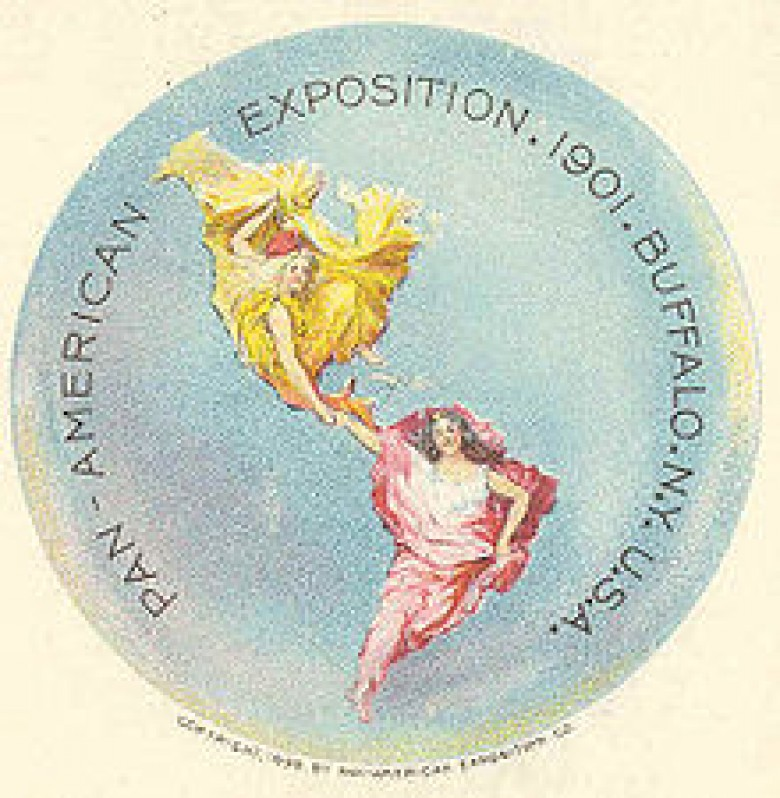There was a time when Buffalo was not known for its winters or for wings, but as the place where a president was shot.
 It should have become known for innovation and electricity. The Pan-American Exposition was lighting up 350 acres of the city with thousands of light bulbs using electricity from Niagara Falls. The revolutionary new x-ray machine was on display. Among the 8 million visitors to this extraordinary world's fair was President William McKinley.
It should have become known for innovation and electricity. The Pan-American Exposition was lighting up 350 acres of the city with thousands of light bulbs using electricity from Niagara Falls. The revolutionary new x-ray machine was on display. Among the 8 million visitors to this extraordinary world's fair was President William McKinley.
A gun shot by anarchist Leon Czolgosz on September 6, 1901, shifted the eyes of the world from innovation to assassination as McKinley, just six months into his second term, teetered between life and death for eight, long days. Ironically, neither electric light nor x-rays were used to search for the bullet that caused the gangrene which ultimately took his life.
Shot! Buffalo's Darkest Day is an epic, original opera which dramatizes this event that came to define Buffalo for many decades. It is being billed as "the biggest show in Buffalo history about Buffalo history.” This may not be hyperbole. A 26 piece orchestra, a 35 member chorus, and a cast of 18 will perform the world premiere at Shea's on June 10 and 12. It is not to be missed.
Composed by ASCAP award-winning Buffalonian Persis Behar, and directed by Emmy award-winning David Grabarkewitz, Shot! also boasts a stellar cast. Internationally acclaimed tenor John Packard of San Francisco Opera Deadman Walking fame will portray Czolgosz, the assassin, and Valerian Ruminski, general director and founder of Nickel City Opera, will perform the role of President McKinley. Renowned performers from Toulouse, Berlin, and Calgary will join them on sets of the Milburn House, the Czolgosz jail cell, and the Pan-American Exposition. Edison footage shown at the Pan-Am and stills of historic Buffalo will be projected on a 40-foot screen. Songs written about Buffalo in 1900 to celebrate the the city will be heard for the first time in more than a century.
 The Pan-American Exposition lit up Bufffalo in May, 1901 and was scheduled to continue through November. "Expositions are the timekeepers of progress," said McKinley during a speech at the Exposition the day before he was shot. "They record the world's advancement. They stimulate the energy, enterprise, and intellect of the people, and quicken human genius." This event was doing all this and more, when it was derailed by the act of a fanatic, casting a pall on the Pan-Am and on Buffalo.
The Pan-American Exposition lit up Bufffalo in May, 1901 and was scheduled to continue through November. "Expositions are the timekeepers of progress," said McKinley during a speech at the Exposition the day before he was shot. "They record the world's advancement. They stimulate the energy, enterprise, and intellect of the people, and quicken human genius." This event was doing all this and more, when it was derailed by the act of a fanatic, casting a pall on the Pan-Am and on Buffalo.
McKinley was greeting attendees in the Exposition’s Temple of Music when he was approached by Czolgosz who shot him twice in the abdomen before his security detail reacted. McKinley hung on for a eight days before succumbing to his wounds.
Vice president Theodore Roosevelt, who had visited the convalescing president, was hastily summoned back to Buffalo when McKinley's condition worsened. He was sworn in as president of the United States at the Ansley Wilcox House on Delaware Avenue within hours of McKinley's demise on September 14. Czolgosz was convicted on September 24 and went to the electric chair (invented in Buffalo in 1881) October 29, 1901, just 45 days after McKinley's death.
A small monument, not much more than a headstone really, marks the site of the assasination, now the median of Fordham Avenue. The McKinley Monument, the huge obelisk in Niagara Square, was raised to much fanfare in 1907 to honor the slain president. The Wilcox House is now the Theodore Roosevelt Inaugral Site. It documents the assasination, the Pan-American Exposition and honors McKinley's successor. The New York State Building, now the Buffalo History Museum, is the only Pan-Am structure still standing. It houses an extensive collection of artifacts and information, including the gun used by Czolgosz to shoot McKinley at the Pan-American Exposition.
Shot! Buffalo's Darkest Day will join these artifacts in helping us understand this defining moment in Buffalo. But it is not an attraction to visit or a monument to drive past. There are just two performances, and they promise to bring this striking event to life on stage at Shea's. Don't miss this unique peek into Buffalo's past.

